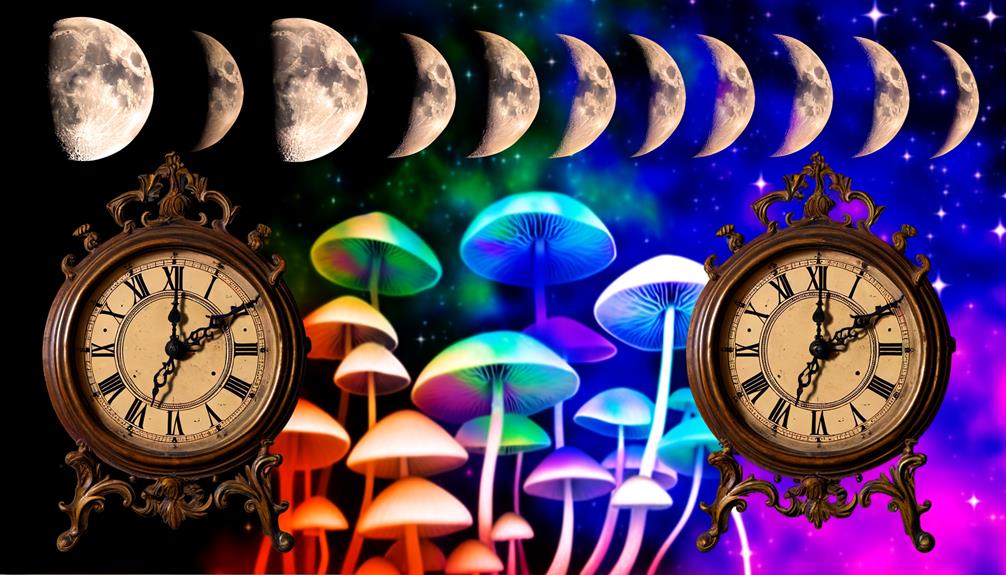Embarking on a journey with shrooms can be akin to stepping onto a roller coaster in the dark; you’re aware of the impending adventure but uncertain about when the first drop will hit. You’ve likely heard tales of vivid colors, profound introspection, and a sense of oneness with the universe, but when exactly does this experience begin? The answer isn’t as straightforward as you might hope, as it hinges on a cocktail of personal and external factors. From the metabolism racing through your veins to the potency of the shrooms cradled in your palm, and even the method you choose to welcome them into your body—each plays a crucial role in determining when you’ll feel the initial whisper of their effects. If you’re curious about navigating this unpredictable timeline and understanding what could potentially accelerate or delay the moment the magic starts, you’ll find that diving deeper into the nuances of these factors will shed light on this mystical voyage.
Understanding Psilocybin Mushrooms
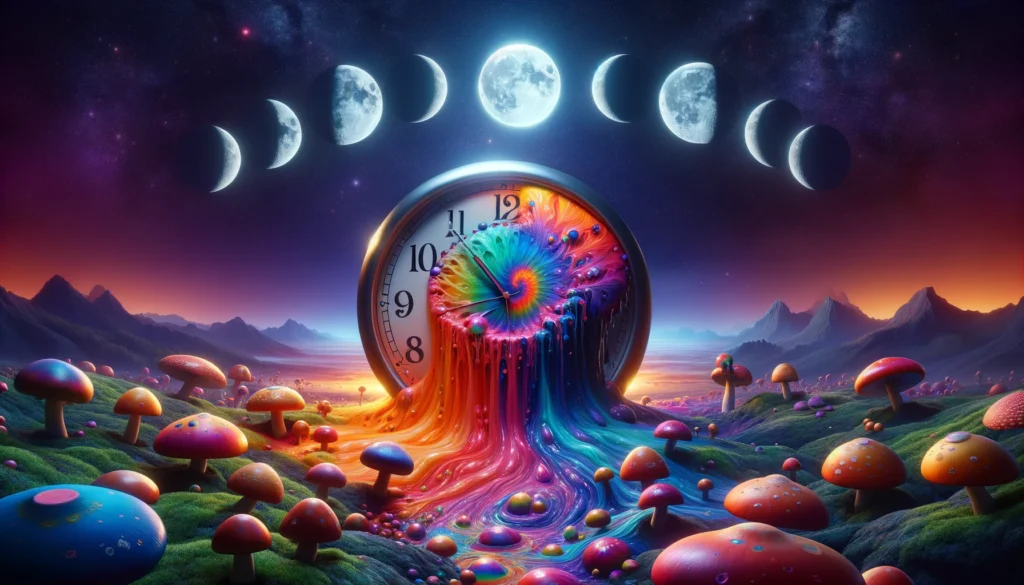
Why’s it crucial to grasp the ins and outs of psilocybin mushrooms before diving into their world? Well, understanding the nuances of these magic mushrooms is essential for a safe and enlightening experience. Psilocybin mushrooms, known for their psychedelic effects, can profoundly alter your perception of reality. But without proper knowledge, you’re more at risk of experiencing a bad trip, which can include intense anxiety or panic.
The effects of these mushrooms vary greatly depending on several factors, such as the dose, your metabolism, and even how you consume them. Eating them on an empty stomach, for instance, can hasten their effects, while a full stomach might delay the onset. These are critical pieces of information to prevent overwhelming experiences.
Moreover, the duration and intensity of the trip can be influenced by your personal tolerance and the potency of the mushrooms. Being aware of these aspects can help you prepare for the experience, making it less likely to encounter unpleasant side effects.
Lastly, considering the potential psychological impact is crucial. Engaging with mental health services administration post-experience for integration and reflection can be beneficial. Understanding psilocybin mushrooms fully equips you with the knowledge to navigate their world safely and meaningfully.
Legal Status of Shrooms
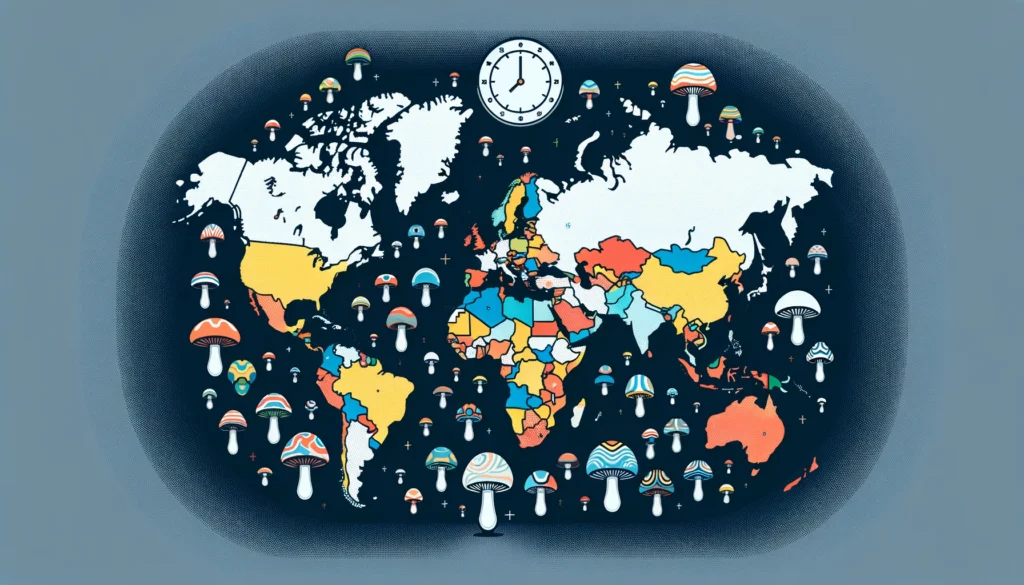
Navigating the legal landscape of psilocybin mushrooms, it’s crucial to understand that they’re currently classified as a Schedule I substance in the U.S., with similar restrictions in many countries worldwide. This classification by the Substance Abuse and Mental Health Services Administration (SAMHSA) implies that shrooms are considered to have a high potential for abuse, with no accepted medical use. It’s a status shared by some of the most strictly regulated substances.
Due to their legal status, possessing, cultivating, or distributing shrooms can lead to severe legal consequences, including fines and imprisonment. While they are among the most popular psychedelics, their illicit nature means that encounters with law enforcement can significantly impact your life. Moreover, if you’re undergoing treatment or are part of a program that requires standard drug tests, psilocybin can be detected, potentially complicating legal and personal situations.
However, it’s worth noting that the legal status of shrooms is evolving. Some regions have begun to decriminalize or legalize their use for medical or recreational purposes. Always make sure you’re up to date with the laws in your area or any area you plan to visit.
The Power of Psilocybin
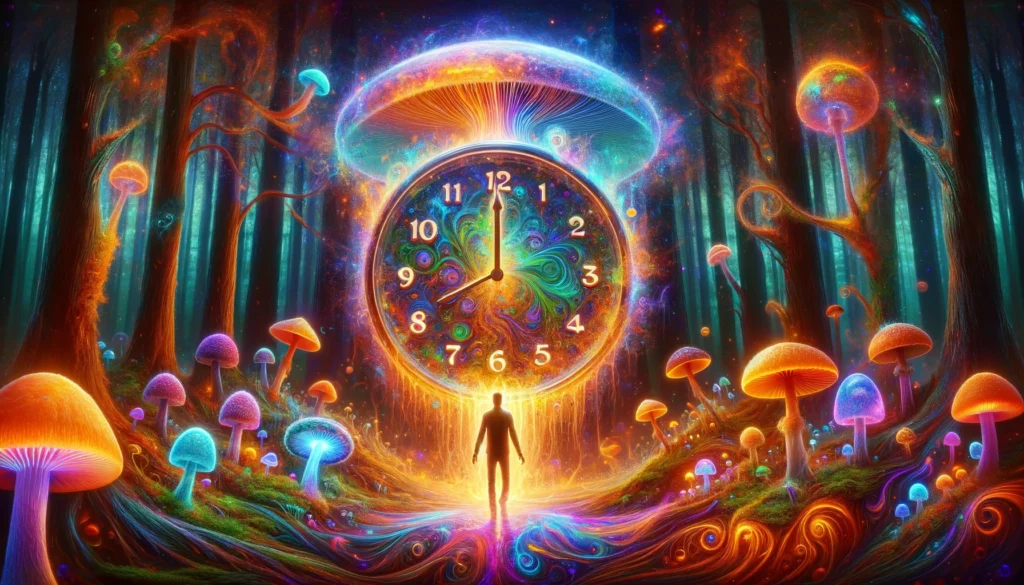
While understanding the legal risks is essential, it’s equally important to explore the profound effects psilocybin can have on the mind and body. Psilocybin, the active compound in magic mushrooms, holds a significant power to alter perception, mood, and thought in ways that are both complex and intriguing. Once ingested, psilocybin is quickly absorbed by your digestive system, and its effects are modulated by your metabolic rate. This means that the intensity and duration of your experience can vary greatly depending on several factors, including how much you’ve eaten beforehand.
The power of psilocybin is evident through its various effects, which include:
- Enhanced sensory perception: Colors might seem brighter, sounds more distinct, and touch more sensitive.
- Emotional amplification: Feelings of euphoria, love, and interconnectedness are common, as well as potential introspective insights.
- Altered sense of time: Time may appear to slow down, enhancing the experience’s intensity.
Understanding how psilocybin interacts with your body helps in appreciating its potential for profound psychological and physiological changes. Remember, the effects are not just dependent on the substance itself but also on individual characteristics like your metabolic rate and the state of your digestive system.
Psilocybin Vs. Amanita Muscaria
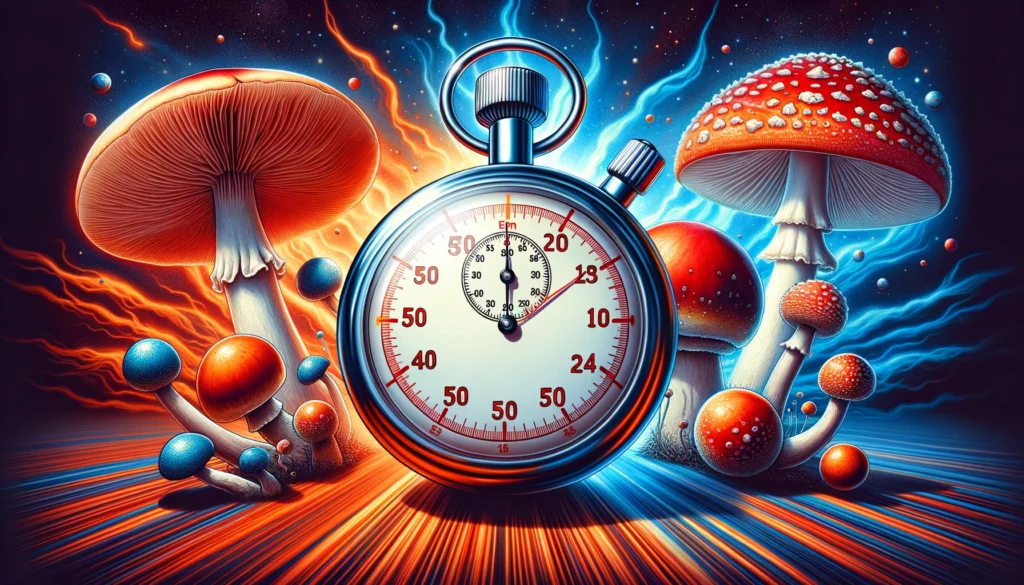
Often, when exploring the world of psychoactive mushrooms, you’ll find yourself comparing psilocybin to Amanita muscaria, each offering unique effects and experiences. Psilocybin, mostly found in certain species of mushrooms, is known for its profound alterations in perception, mood, and thought. On the other hand, Amanita muscaria, recognized by its iconic red and white cap, contains muscimol, which induces a state of euphoria and tranquility.
To help visualize the differences, consider the following table:
| Aspect | Psilocybin | Amanita Muscaria |
| Main Compound | Psilocin and psilocybin | Muscimol |
| Effects | Altered perception, mood, and thought | Euphoria, tranquility, relaxation |
| Method of Consumption | Often ingested directly or made into mushroom tea | Traditionally prepared in various ways to reduce toxicity |
While psilocybin mushrooms take about 30 to 120 minutes to kick in, depending on factors like metabolic rate and method of consumption, Amanita muscaria’s effects can vary widely based on preparation and individual sensitivity. Whether you’re consuming these mushrooms directly or brewing a mushroom tea, it’s crucial to understand the nature of what you’re ingesting and the potential impacts on your mind and body.
Initial Onset Time
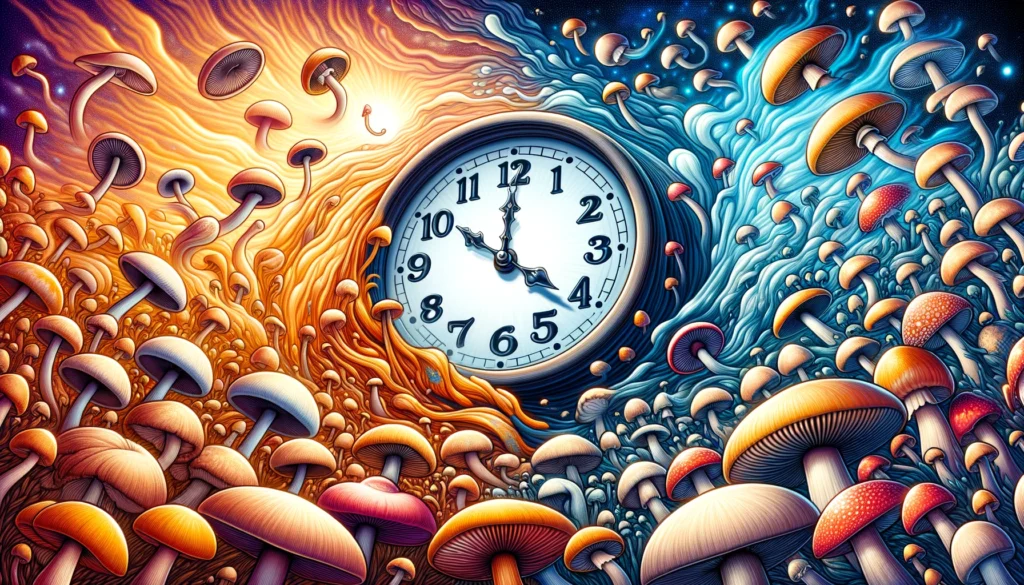
Understanding the initial onset time of shrooms is crucial as it can vary from 30 minutes to 2 hours, depending on several factors like your metabolism and how you’ve ingested them. When you’re eager to feel the effects, this waiting period can seem lengthy, but it’s a natural part of the process. Knowing what influences the time it takes for shrooms to take effect can help you plan your experience more effectively.
To engage you further, consider these points:
- Metabolism and Physical Condition: Your body’s metabolic rate and physical condition play significant roles. If you have a faster metabolism, you might feel the effects sooner.
- Method of Ingestion: How you ingest shrooms affects the onset time. Eating them directly can lead to a quicker onset compared to more complex ingestion methods like brewing tea.
- Stomach Contents: Taking shrooms on an empty stomach can accelerate the onset, as there’s less material in your stomach to digest alongside the shrooms.
Factors Influencing Onset
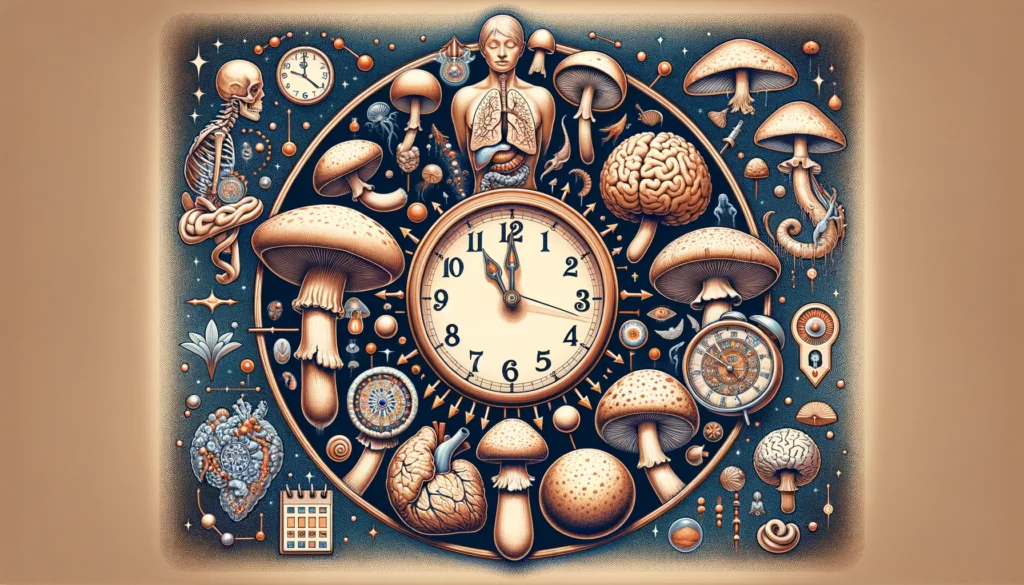
Several factors, such as your metabolism, weight, and how you ingest shrooms, can significantly affect how quickly they kick in. The time it takes for shrooms to kick in isn’t one-size-fits-all; various factors play into the onset time. For example, if you’ve got a fast metabolism or you’re on the lighter side, you might find that shrooms kick in quicker for you. Conversely, if your metabolism is slower or you have a higher body weight, it might take a bit longer.
The method of ingestion is another key player in the factors influencing onset. Eating shrooms on an empty stomach can speed up the process, as there’s nothing else for your body to digest. On the other hand, if you choose to brew them into tea or mix them with food, the onset might be a tad slower but could also alter the experience’s intensity.
Lastly, the potency of the shrooms and your personal tolerance will also dictate how long does it take for the effects to begin. Each batch of shrooms can vary in strength, so even if you’re used to a certain onset time, a particularly potent batch could surprise you.
Method of Consumption
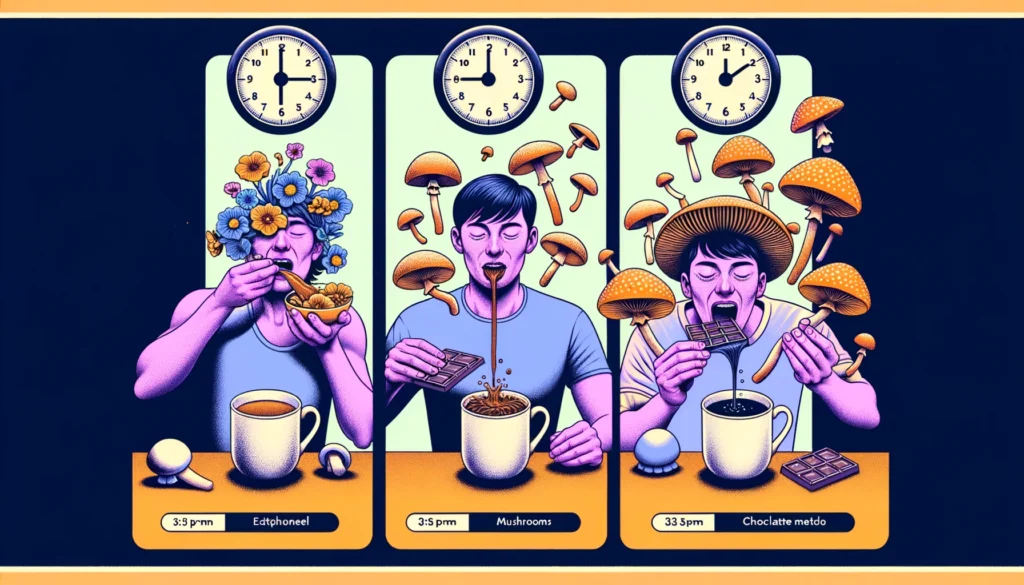
When it comes to shrooms, the way you consume them significantly impacts how quickly you’ll feel the effects. Your method of consumption can vary, and this choice plays a crucial role in determining how long it takes for the shrooms to kick in and when you’ll hit the peak effects. Whether you’re taking shrooms for the first time or you’re a seasoned explorer, understanding the different ways shrooms can be taken is key to managing your experience.
Here are a few common methods: – Eating them raw or dried: This is the most straightforward method, but the onset can vary depending on whether your stomach is full or empty. – Brewing tea: Shrooms steeped in hot water can lead to a faster absorption rate, potentially bringing on effects more quickly. – Incorporating into food: While this can make for a more pleasant eating experience, it might delay the onset of effects since the shrooms are digested along with the food.
Impact of Stomach Fullness
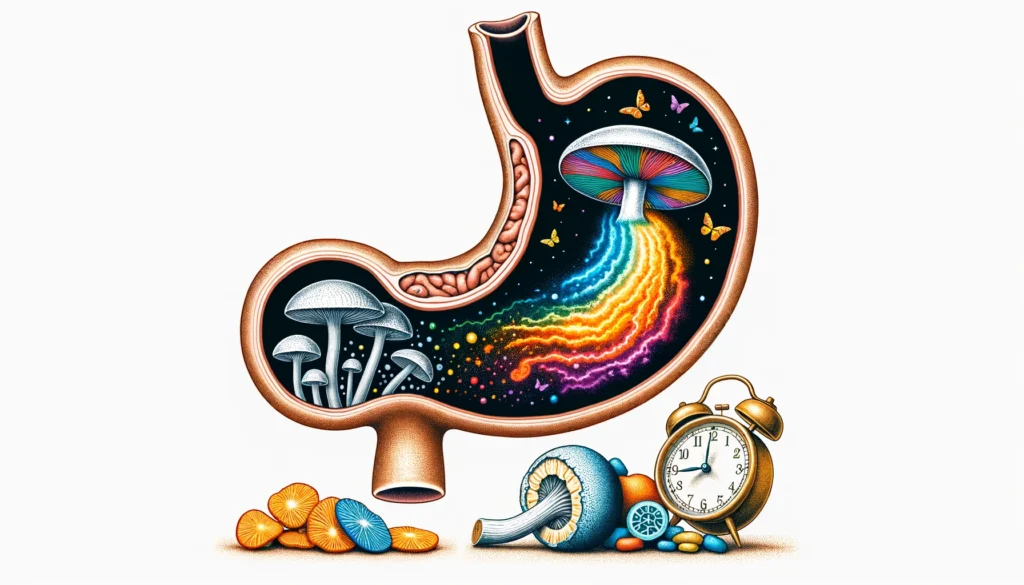
Exploring how you consume shrooms, it’s crucial to consider that an empty or full stomach significantly influences their onset time and overall effects. If you dive into this experience on an empty stomach, you’re likely to feel the psychedelic effects quicker. This rapid onset is because there’s no food to slow down the absorption of psilocybin, the active compound in mushrooms. On the flip side, having a full stomach can delay these effects but might also contribute to a more extended, perhaps smoother experience.
The Substance Abuse and Mental Health Services Administration (SAMHSA) highlights the importance of understanding factors like the impact of stomach fullness to avoid potential substance abuse. Knowing how long mushrooms stay in your system and planning your intake can prevent an overwhelming experience, especially if you have an upcoming drug test or other commitments. Remember, the aim is to ensure a safe and positive experience. So, whether you decide to eat before or fast, being mindful of how these choices affect the duration and intensity of the trip is key to navigating your journey with shrooms responsibly.
Dosage and Effects
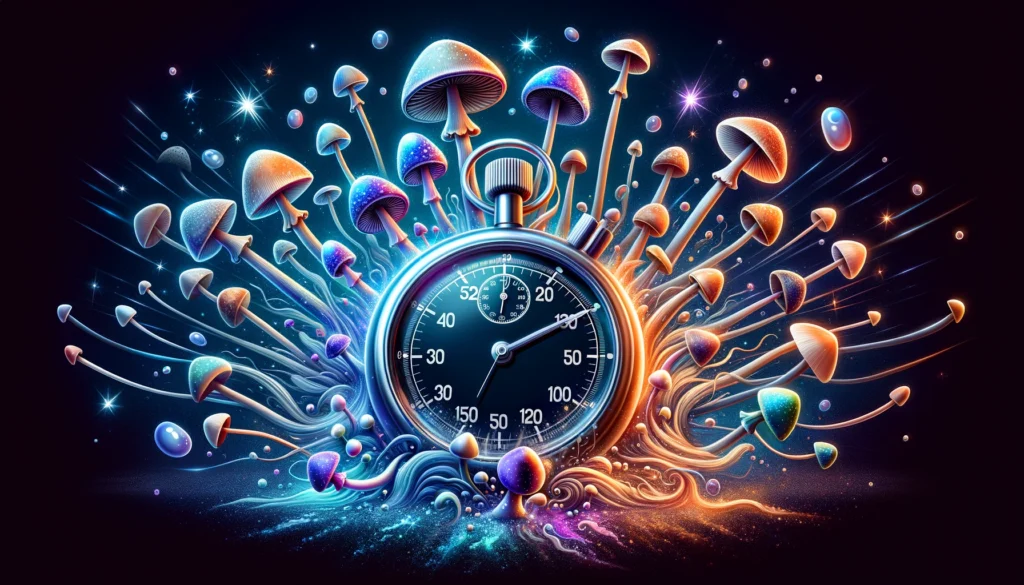
Understanding how much you take is crucial, as the dosage directly influences the intensity and duration of shroom effects. The Substance Abuse and Mental Health Services Administration (SAMHSA) highlights the importance of being aware of the dosage and its potential effects on your mental health. Depending on how much you consume, you might experience a range of sensations, from mild visual enhancements to profound alterations in perception and thought.
To engage with this topic better, consider the following:
- Dosage guidelines can vary, but starting with a lower dose is recommended, especially if you’re new to shrooms.
- Effects can include altered senses, time perception, and emotional shifts. The intensity of these effects can be directly tied to the amount ingested.
- Detection methods such as saliva tests, hair follicle analysis, and blood tests exist, but their relevance primarily concerns situations involving substance abuse investigations rather than personal exploration.
Mushroom Species Variations
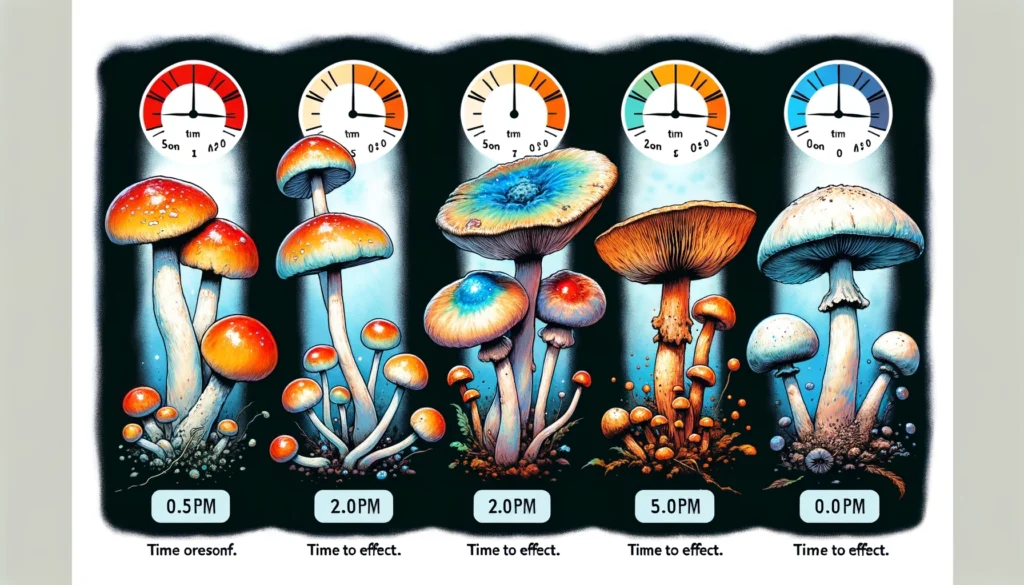
After grasping how dosage impacts your experience, it’s crucial to consider how different mushroom species can vary in potency and effects. The Substance Abuse and Mental Health Services Administration (SAMHSA) stresses the importance of understanding these variations, as they play a significant role in the effects one might experience. Mushroom species variations aren’t just a small detail; they can dramatically alter the onset and intensity of the psychedelic journey.
Among the widely used species, Psilocybe cubensis is known for its predictability and moderate potency, making it a popular choice. However, venturing into species like Psilocybe azurescens, one of the most potent, can lead to a much more intense and quicker onset of effects. This variance underscores the necessity to research and respect the specific characteristics of the mushroom species you’re considering.
Moreover, it’s interesting to note that while methods to detect shrooms in the body are advancing, understanding the specific species consumed can provide valuable insights into the expected experience. Recognizing these variations is essential, whether you’re a seasoned psychonaut or someone exploring the realm of psychedelics for the first or second time.
The Peak Experience
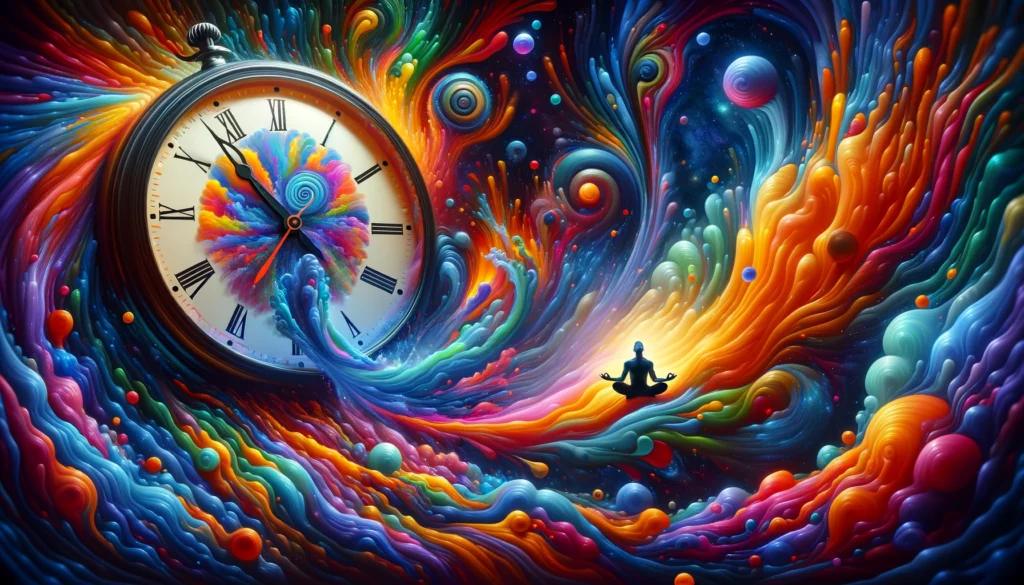
The peak experience, usually hitting about 1.5 to 2.5 hours after you’ve ingested shrooms, is when the psychedelic journey reaches its most intense phase. During this time, the Substance Abuse and Mental Health Services Administration (SAMHSA) emphasizes the importance of having a safe, supportive environment, as the effects can be profound and unexpectedly powerful. It’s crucial to understand how long these substances stay in your system and the potential for substance abuse and mental health impacts.
To navigate the peak safely, consider the following: – Stay Hydrated: Keeping water at hand helps manage the physical effects of shrooms. – Have a Trip Sitter: Someone sober who can help you stay grounded if things get too intense. – Create a Comfortable Setting: Ensure you’re in a safe, familiar place to help manage any disorienting effects.
The Comedown Phase

As you begin to navigate the comedown phase, you’ll likely notice a shift towards more reflective or relaxed states of mind. This period, following the peak of your shroom experience, can vary significantly in duration and intensity, depending on several factors such as the dosage you’ve consumed and your personal metabolism. It’s a time when the vivid and intense sensations start to ebb away, leaving room for introspection and a sense of calmness.
Understanding the potential psychological impact during this phase is crucial. Some find it beneficial to engage in activities that promote reflection and integration of the experience. This might include journaling, meditative practices, or simply discussing your thoughts and feelings with a supportive friend.
Here’s a quick overview to help you prepare for the comedown phase:
| Aspect | Description | Tips |
| Duration | Varies based on individual factors | Stay hydrated, rest |
| Feelings | Relaxation, introspection | Engage in calm activities |
| Psychological Impact | Can be significant | Reflect, integrate experience |
| After-effects | Shorter, less intense | Safe, comfortable environment |
Duration in the System
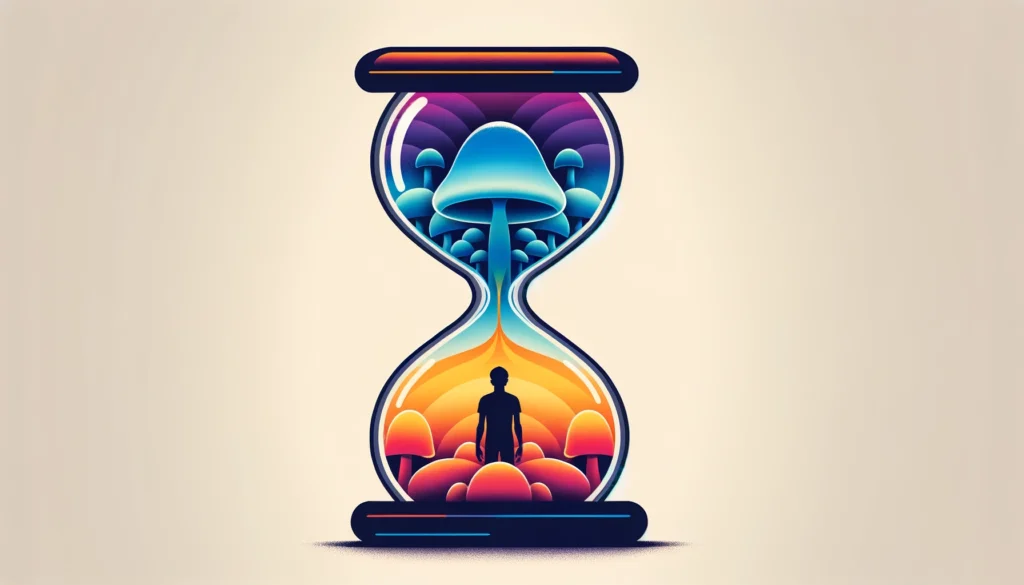
Understanding how long shrooms stay in your system is crucial for planning and ensuring a positive experience. While the trip itself might last between 5 to 10 hours, with peak effects around 1.5 to 2.5 hours after ingestion, the longevity of psilocybin in your system can vary. Several factors influence this duration, including your metabolism, the amount consumed, and your overall resistance to the compound.
To help you gauge how long shrooms might linger in your body, consider these points:
- Metabolism: Individuals with a faster metabolism may process and eliminate psilocybin quicker than those with a slower metabolic rate.
- Quantity Consumed: The more psilocybin mushrooms you consume, the longer they might stay in your system, affecting how long the effects last.
- Food Intake: Eating shrooms on an empty stomach can lead to faster absorption, but it also means the substances might pass through your system quicker.
Recognizing Misuse Side Effects
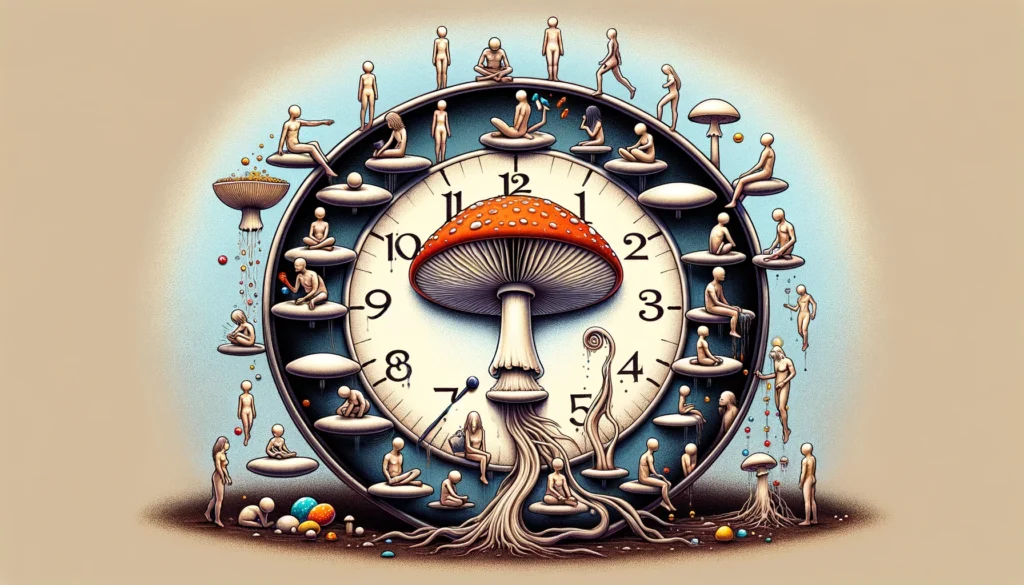
While it’s crucial to know how long shrooms can affect your system, it’s equally important to recognize the side effects that indicate misuse. If you’re experiencing or observing someone with the following symptoms, it may be a sign that shrooms are being misused. These effects can not only put the individual at risk but can also lead to emotional and behavioral issues. Mixing shrooms with alcohol or other drugs significantly increases these risks.
| Symptom | Possible Emotional Response |
| Anxiety, psychosis, scary illusions | Fear, insecurity, confusion |
| Vomiting, severe headaches, convulsions | Physical distress, discomfort |
| Altered sense of space and time, disorientation | Loss of control, panic |
It’s pivotal to approach these situations with empathy and understanding. The emotional turmoil experienced during such episodes can be profoundly unsettling. If you or someone you know is facing these side effects, seeking professional help is a crucial step towards recovery. Remember, it’s not just about the physical symptoms but also the emotional and psychological impact these experiences can have.
Addressing Shroom Dependence
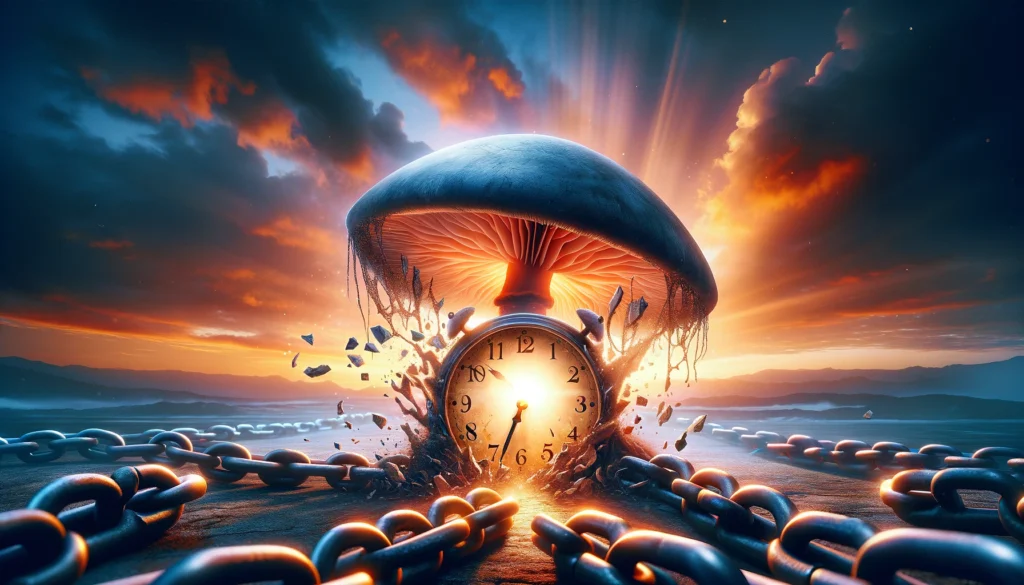
To effectively address shroom dependence, it’s crucial to recognize how individual factors like metabolism and the quantity consumed can influence the duration and intensity of their effects. Understanding these factors is not just about ensuring a safe and controlled experience; it’s about preventing the cycle of dependence that can emerge from chasing those profound effects without considering the psychological and physiological impacts.
Here are three key points to remember:
- Know Your Limits: Understanding your body’s reaction to shrooms, including how quickly they take effect and how long those effects last, can help you avoid overconsumption.
- Seek Professional Help: If you’re struggling with shroom dependence, professional guidance from therapists or support groups familiar with psychedelic experiences can provide the tools for managing and overcoming this challenge.
- Integration and Reflection: Post-experience integration and reflection are essential. They can help you understand the root causes of your dependence and find healthier ways to address those underlying issues without relying on substances.
Addressing shroom dependence is a multifaceted process that involves a deep understanding of both the substance and oneself. By focusing on these aspects, you’re taking a significant step towards healthier, more conscious use of psychedelics.
